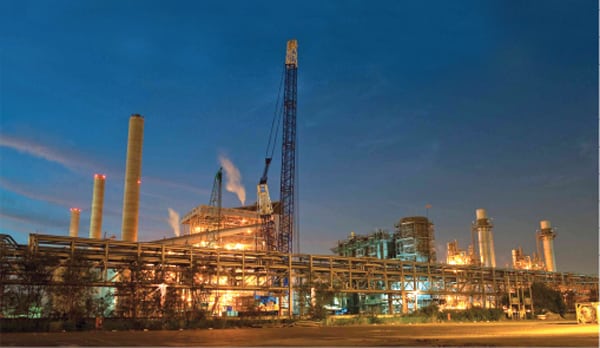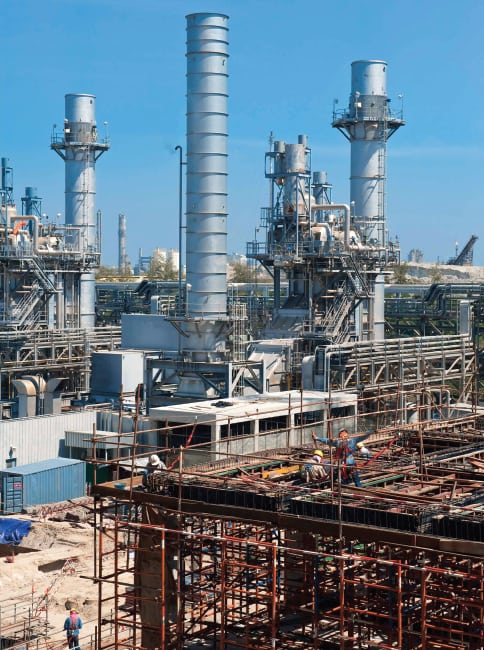TOP PLANTS: Glow Phase 5 Combined Cycle/Cogeneration Project, Rayong, Thailand
 |
| Courtesy: Black & Veatch |
Glow Energy’s 382-MW Glow Phase 5 power plant in Thailand exceeded early expectations by packing into a tightly constrained space more capacity than anyone thought possible. The plant’s engineering feat earns it recognition as a POWER Top Plant for 2012.
When Mark McDermott of Black & Veatch first saw the brownfield construction site in Thailand intended for the Glow Phase 5 combined cycle power plant, he did a double take. The project manager and associate vice president of the Overland Park, Kan.–based engineering and construction firm looked over the site that measured 100 meters by 100 meters and that was hemmed in by other industrial and power facilities. He knew a combined cycle plant typically required at least 50% more land to accommodate the boiler, turbine, generator, stack, heat recovery steam generator (HRSG), transformers, and other equipment. But to provide electricity and all-important steam to nearby industrial users in what McDermott called Thailand’s equivalent of Houston’s industrial area, the power plant had to fit on this site.
Glow had already realized during the initial project development in 2006 that space was very limited, and consequently, it would eliminate the option of a single shaft configuration, which needed a plant length of about 130 meters. But Glow also liked that the site offered access to a gas-insulated substation, seawater cooling intake and discharge, a demineralized water plant, and a central control room where the human machine interface for the new combined cycle plant could be located.
So, having been “hit hard in the face” by site realities, McDermott and his team from Black & Veatch’s Bangkok office engineered a solution that enabled the owner, Glow Energy, a unit of IPR GDF SUEZ Energy International, to site a 380-MW F-class machine. The 1 x 1 combined cycle train was an upgrade from the E-class machine with an HRSG concept that Glow Energy initially thought was all that would fit. Project construction began in 2008 and the cogeneration facility entered service in August 2011, offering more electrical output and more steam at a lower operating cost than was first thought possible.
Not only that, but given the site configuration, Glow Phase 5 also may produce the most megawatts per square meter of any power plant in Asia, McDermott jokes.
POWER recognizes the Glow Phase 5 project as a 2012 Top Plant, citing the project team’s success in engineering and constructing a combined cycle/cogeneration facility that exceeded client expectations and that supplies both electricity and steam to a growing industrial complex.
Growing Electricity Demand
Thailand ranks among the largest per-capita power consumers in Southeast Asia and has an installed generating capacity of around 32 GW. Demand from local steel, textiles, and rubber industries has resulted in power demand increasing at an annual rate of as much as 3.5%. The Thai government plans to increase the country’s total installed power plant capacity to 52 GW by 2020. With a share of just less than 70%, gas-fired power plants today account for the majority of Thailand’s power generating capacity.
The World Bank called Thailand “one of the great development success stories,” with sustained strong growth and impressive efforts to reduce poverty. In the decade that ended in 1995, the Thai economy was one of the world’s fastest growing, at an average rate of 8% to 9% per year. After recovering from the Asian Crisis of 1997–1998, the Thai economy took off again, with growth averaging 5% per year in the period 2002–2007. Economic growth at just below 4% during the first three quarters of 2011 was interrupted by historic flooding in October and November 2011 in industrial areas north of Bangkok. Floods crippled the manufacturing sector and led to a revised growth rate of 0.1% for the year.
Glow said its power-generating plants remained operational during the floods but that its customers and suppliers were affected. The nation’s industrial sector was poised to recover starting in the second quarter of 2012, and the government anticipated the economy would grow at a rate of between 5.5% and 6.5% this year.
GDF SUEZ Energy International is Glow Energy’s major shareholder and is a division of the GDF SUEZ Group, one of the largest international industrial and services groups in the world. Glow Group generates and supplies electricity to the Electricity Generating Authority of Thailand under that country’s small power producer and independent power producer programs. Glow also supplies electricity, steam, industrial water, and services to large industrial customers principally in the Map Ta Phut area southeast of Bangkok on the Gulf of Thailand.
Glow Group’s combined installed capacities include 3,078 MW of power (excluding a 110-MW LM6000-based combined cycle plant under construction), 1,206 tons per hour of steam, and 4,860 cubic meters per hour of processed (clarified and demineralized) water.
As industrial expansion continues in Thailand’s Map Ta Phut area (a major industrial zone), so too does demand for electricity and process steam. To serve this growing demand, Glow Group, a leading utilities provider in Map Ta Phut, initiated a combined cycle cogeneration power plant project in the Map Ta Phut Industrial Estate, Muang district, Rayong province. The project occupies what had been a vacant area of the existing power plant complex of Glow SPP 3 Co. Ltd., a unit of Glow Group.
Project Specifications
The Glow Phase 5 project shown in Figure 1 was part of a planned expansion to Glow’s existing facility in Thailand and was designed to deliver up to a nominal 382 MW of electricity under condensing operation. It is also capable of exporting up to 160 tons/hour of high-pressure steam to the existing Glow steam network.
 |
| 1. Packing plenty of heat and power into a small space. Glow Phase 5 is a 382-MW 1 x 1 combined cycle train that supplies electricity and process steam to a growing industrial area in Thailand. Courtesy: Black & Veatch |
Major equipment suppliers included Siemens for the combustion and steam turbine/generators and condenser, Hangzhou Boiler Group for the triple-pressure with reheat HRSGs, Hyundai for the generator step-up transformers, KSB for the condensate and feedwater pumps, and Flowserve for the circulating water pumps.
Construction Timeline and Challenges
Glow Energy Plc in July 2008 signed a $302 million contract with a consortium made up of Black & Veatch and Marubeni for equipment supply and construction. A notice to proceed soon followed. Project construction began in 2009, and the project was commissioned and entered service in August 2011.
Due to the site’s limited laydown area, equipment had to be stored five kilometers away and scheduled for just-in-time delivery. This arrangement essentially doubled the amount of equipment and material handling, but it proved essential given the site’s space limitations.
“We didn’t want equipment too early or too late” due to the detailed construction lift sequences mapped out for the project, McDermott said.
The Glow Phase 5 construction schedule was designed around limiting the amount of equipment on site due to space restrictions. A 2-D rendering showed the site was too small for the combined cycle plant, with the ladder on the HRSG stack seemingly overlapping expansion loops of existing steam lines. However, a 3-D study revealed sufficient clearance existed for all equipment, along with access for maintenance once the plant was up and running and helped manage the site’s restricted area.
For example, a turntable had to be used to bring in the gas turbine and transformers, turn them in place, and slide them into position due to limited space between the new project and the existing circulating fluidized bed boiler installed in the 1990s. And early in the project, the unit’s electrical building had to be relocated to a position between the steam turbine and the gas turbine. The building’s original location conflicted with where a crane had to be located to install the HRSG.
“We ended up with a building under a building,” McDermott said of the electrical building’s final location.
During construction, the engineering, procurement, and construction partners also encountered brackish groundwater, which had caused corrosion problems with an existing carbon steel fire protection system. The solution was to specify valves capable of withstanding a seawater environment.
The project sourced equipment from more than 20 countries across several continents. Shipping logistics, language barriers, time zone impediments all proved difficult, yet were successfully addressed.
Constructing a plant in the midst of existing operating units required close coordination and innovative engineering and planning to maintain the project schedule while supporting the needs of the existing operational facilities.
Operating Characteristics
The natural gas–fired plant includes one Siemens SGT5-4000F combustion turbine generator exhausting into one triple-pressure HRSG and one reheat condensing steam turbine generator. The completed combined cycle cogeneration plant provides greater operational flexibility in generating electricity and steam for its customers.
The plant complies with all Thai environmental regulations. Adjustments were made in the plant design in the areas of SO2 monitoring and residual chlorine monitoring to ensure compliance with the permit.
— David Wagman is executive editor of POWER.